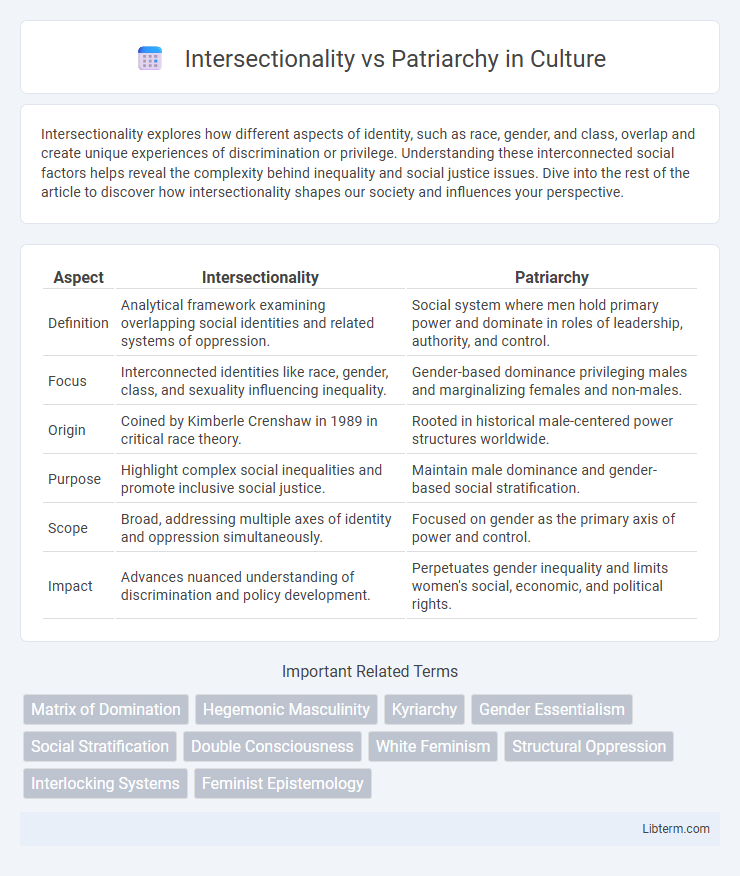Intersectionality explores how different aspects of identity, such as race, gender, and class, overlap and create unique experiences of discrimination or privilege. Understanding these interconnected social factors helps reveal the complexity behind inequality and social justice issues. Dive into the rest of the article to discover how intersectionality shapes our society and influences your perspective.
Table of Comparison
| Aspect | Intersectionality | Patriarchy |
|---|---|---|
| Definition | Analytical framework examining overlapping social identities and related systems of oppression. | Social system where men hold primary power and dominate in roles of leadership, authority, and control. |
| Focus | Interconnected identities like race, gender, class, and sexuality influencing inequality. | Gender-based dominance privileging males and marginalizing females and non-males. |
| Origin | Coined by Kimberle Crenshaw in 1989 in critical race theory. | Rooted in historical male-centered power structures worldwide. |
| Purpose | Highlight complex social inequalities and promote inclusive social justice. | Maintain male dominance and gender-based social stratification. |
| Scope | Broad, addressing multiple axes of identity and oppression simultaneously. | Focused on gender as the primary axis of power and control. |
| Impact | Advances nuanced understanding of discrimination and policy development. | Perpetuates gender inequality and limits women's social, economic, and political rights. |
Understanding Intersectionality: A Brief Overview
Intersectionality is a critical framework that examines how multiple social identities, such as race, gender, class, and sexuality, intersect to create unique experiences of oppression and privilege. Patriarchy refers specifically to a social system where men hold primary power, reinforcing gender-based inequalities. Understanding intersectionality allows for a more comprehensive analysis of how patriarchal structures differently impact individuals depending on their intersecting identities.
Defining Patriarchy in Social Structures
Patriarchy in social structures refers to a system where men hold primary power and dominate roles in political leadership, moral authority, social privilege, and control of property. This hierarchy often leads to the systemic marginalization of women and non-binary individuals across economic, cultural, and legal domains. Understanding patriarchy requires analyzing how gender inequalities are institutionalized and maintained through laws, traditions, and social norms.
Historical Roots of Patriarchy and Intersectionality
Patriarchy, deeply rooted in ancient agrarian societies, established male dominance through kinship systems and property inheritance favoring men, shaping centuries of social hierarchy and gender roles. Intersectionality emerged from Black feminist thought in the late 20th century, recognizing overlapping social identities like race, gender, and class that compound systemic oppression beyond isolated experiences of patriarchy. Understanding patriarchy's historical entrenchment alongside intersectionality highlights the complexity of power dynamics and the necessity for multifaceted approaches to social justice.
How Intersectionality Challenges Patriarchal Norms
Intersectionality challenges patriarchal norms by highlighting how overlapping identities such as race, class, gender, and sexuality create complex systems of oppression beyond a singular focus on gender inequality. It exposes the limitations of traditional feminism that often centers on the experiences of privileged women, emphasizing the need for inclusive approaches that address multiple, intersecting forms of discrimination. This framework demands a reevaluation of power structures, pushing for social justice that acknowledges and dismantles the interconnected mechanisms sustaining patriarchy.
Gender, Race, and Power: The Overlapping Dynamics
Intersectionality reveals how gender and race intersect to shape unique experiences of oppression within patriarchal power structures, emphasizing that power inequalities cannot be understood through gender alone. Patriarchy systematically privileges male dominance but often interacts with racial hierarchies to enforce compounded social and economic disadvantages. Analyzing overlapping dynamics of gender, race, and power highlights the necessity of addressing multiple axes of identity for effective social justice interventions.
The Impact of Patriarchy on Marginalized Groups
Patriarchy enforces systemic inequalities that disproportionately affect marginalized groups, including women of color, LGBTQ+ individuals, and low-income communities, by intersecting with race, class, and gender. This interlocking system of oppression restricts access to resources, legal protections, and social mobility, intensifying discrimination and exclusion. Understanding patriarchy through an intersectional lens reveals the compounded impact on marginalized populations, highlighting the necessity for inclusive social justice frameworks.
Intersectionality in Feminist Movements
Intersectionality in feminist movements emphasizes the interconnected nature of social categorizations such as race, class, gender, and sexuality, highlighting how overlapping identities create unique modes of discrimination and privilege. This approach challenges patriarchal structures by acknowledging diverse experiences and advocating for more inclusive policies that address systemic inequalities across multiple dimensions. Intersectional feminism advances social justice by ensuring marginalized voices are recognized and integrated within broader gender equality efforts.
Case Studies: Real-life Examples of Intersectional Oppression
Case studies such as the experiences of Black women in the workplace highlight the complex layers of intersectional oppression, where racial discrimination intersects with gender bias, creating unique challenges not addressed by conventional feminist or anti-racist frameworks alone. Research on LGBTQ+ people of color reveals how intersecting identities subject individuals to compounded marginalization within both patriarchal structures and broader societal norms. These real-life examples demonstrate that addressing patriarchy effectively requires an intersectional approach to dismantle overlapping systems of power and inequality.
Strategies for Addressing Patriarchal Inequalities through Intersectionality
Intersectionality-based strategies address patriarchal inequalities by analyzing how overlapping social identities such as race, gender, class, and sexuality create unique experiences of oppression. Policies targeting patriarchal structures benefit from incorporating intersectional frameworks that emphasize inclusivity and recognition of marginalized groups. Empowering grassroots movements and promoting diverse leadership enhances the effectiveness of dismantling systemic inequalities embedded in patriarchal institutions.
Toward an Inclusive Future: Redefining Equality
Intersectionality recognizes the overlapping systems of oppression, including race, gender, and class, which shape individuals' experiences within patriarchal societies. Patriarchy enforces hierarchical structures privileging men, often marginalizing women and minority groups. Redefining equality requires inclusive policies that address multiple identity factors simultaneously, fostering a future where social justice transcends singular dimensions of discrimination.
Intersectionality Infographic

 libterm.com
libterm.com